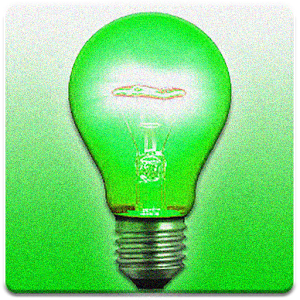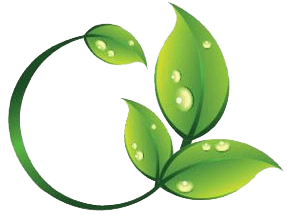Giving Growth the Green Light
Blue and Red light are both essential for good plant development but Green light is often overlooked. The common perception is that since leaves are green, plants reflect green light rather than absorbing it. Although this is true, green light does trigger responses in plants, hence its' importance.
Green Light Response
Green light either triggers specific processes in plant tissues, or serves as a check on the effects of light at either ends of the spectrum. Plants have sensitive light receptors known as phytochromes and cryptochromes.
Phytochromes detect light from the red end of the spectrum and cryptochromes detect light from the blue end. These sensors are not as efficient at responding to green light as they are at responding to light at the blue or red ends of the visible spectrum.
The phytochromes, however, are the primary mechanisms plants use to adjust and survive in lower levels of light. The green light receptors inform the plant of unfavorable lighting conditions so the plant can change accordingly.
Green light passes through plant tissue more efficiently than red or blue light. This means plants grown in dense shade, making use of the available green light, produce seeds and seedlings that are better adapted to growing in similar environments.
The germination rate decreases in low-light environments, but the seeds that do germinate are better suited to their surroundings.
A 2012 study (Zhan and Folta) using Arabidopsis thaliana found plants exposed to high amounts of green light during early development grew as if they were growing in shade.
This phenomenon continued when the plants were then exposed to blue and red lights.
How Young Plants Respond to Green Light
As seedlings produce their embryonic first leaves, they are not producing large amounts of chlorophyll. The available green light seemingly helps fill that void until the plants are able to photosynthesize more effectively on their own.
Green light is also important to help promote dense growth. As much of the available light is absorbed and used by the upper canopy, the leaves below need to adapt to make use of the green light that is filtered through.
What a Grower Needs to Know About Using Green Lights
Another benefit of green light is making working conditions better on the grower. Monochromatic light or even a combination of red and blue light can cause eye strain if growers work under those conditions for any appreciable amount of time.
A plant’s true colors may not be fully visible to the observer, potentially masking the ability to spot the early stages of nutrient deficiencies or the onset of pest or pathogen issues.
Supplemental green hand-held or plug-in lighting can sometimes be used to work with plants at night without disrupting the night cycle photoperiod.
Yields and Growth of Plants Exposed to Green Light
In the last several decades, various trials using different types of lighting aimed to determine which combination is best for growth and yields.
One study (Went, 1957; Klein et al., 1965) compared results when tomatoes were exposed to red and blue light versus white light containing red, blue and green wavelengths. The tomatoes exposed to the white light were actually somewhat inhibited as measured by the dry weight of the bio-mass of their seedlings.
This suggests green light impedes, to an extent, the ability of plants to reach the potential of plants exposed to just red and blue lights.
Similar studies were performed using near ultraviolet and green light to determine the effects on plant growth. Results as far back as the 1960s revealed that light in the green wavebands (510-585 nm) repressed the growth of a wide range of organisms, including algae, fungus, higher plants and even plant cell cultures (Klein, 1964; Klein et al., 1965).
Other studies found green light can greatly stimulate the flowering process in plants. Recent results suggest the heading of some plants can be increased by as much as 50% with green-yellow light at 540 nm (Kasajima et al., 2007).
A Michigan State University Extension study (Runkle and Wollaeger, 2014) found plants grown with 50% green and 50% red light were about 25% shorter than those grown under only red light, but about 50% taller than plants grown under more than 25% blue light, proving blue light suppressed extension growth more than green light in an enclosed environment.
Researchers determined using 25% green light could substitute for the same percentage of blue light without affecting fresh weight, but the electrical efficiency of green LEDs was much lower than blue LEDs.
Several NASA studies on the effects of using different amounts of green light also reveal similar results.
Trials done with lettuce showed that light with 5% green wavelengths had little impact on total mass, but that when green light levels were increased, it was not only a waste of energy, but it significantly hindered plant growth (Kim et al., 2004).
NASA wants astronauts to be able to grow some of their own food while in orbit and has been extensively researching hydroponics and lighting for plant growth.
Types of Green Light Bulbs for Growers
For growers thinking of adding green lights to their indoor crop production scheme, there are several ways to do so. Green lights are available in bulbs, tubes and LED configurations.
They are also available as T5 fluorescent tubes for those with standard ballasts. For those with traditional screw-in sockets, numerous manufacturers produce green bulbs emitting as low as 5 W.
For LEDs, green lights may be part of an array with red and blue lights, or may come as solid green. There are green LED lights that operate by battery, as well as those that plug into a standard wall outlet.
They can be configured into flashlights, work lights, wrist lights, head lamps and even embedded into hats and glasses.
Though not as ubiquitous as red or blue lights, green lights can be found in grower supply stores with just a little bit of searching. White grow lights can also contain a certain amount of green light in them for those who don’t want to commit to a full green light but want to try to add a bit to their set-up.
Though it appears that green light is an impediment to plant growth, it seems to be a check on other plant systems.
Nature is full of examples of these seemingly opposing purposes acting in concert to yield results that are best for organisms and their respective systems. Green light is not apparently useful for plant metabolism, but it does seem to play a role in plant form and composition, as well as being a catalyst for the better use of other types of lights when plants are grown in unfavorable conditions.
It also appears to be a natural growth regulator and could be used in instances where shorter, fuller crops are desired.
Plants that are more tolerant of shade, or actually thrive in it, are better suited to receive some amount of green light. This is useful for growers of houseplants such as Aspidistra and Philodendron.
What does this mean for the home grower? If all other systems are in good balance, green light may not be necessary. If systems are not in balance, however, the addition of green light may help your plants make better use of the light they are receiving.
Many thanks to Maximum Yield for the information above


